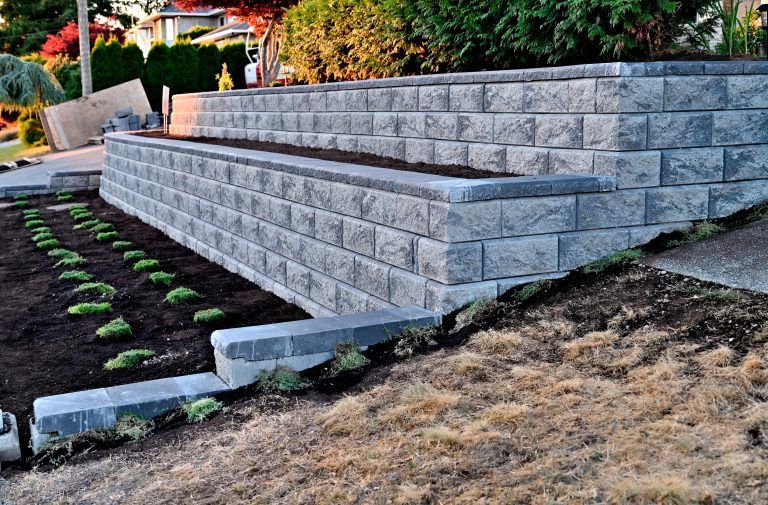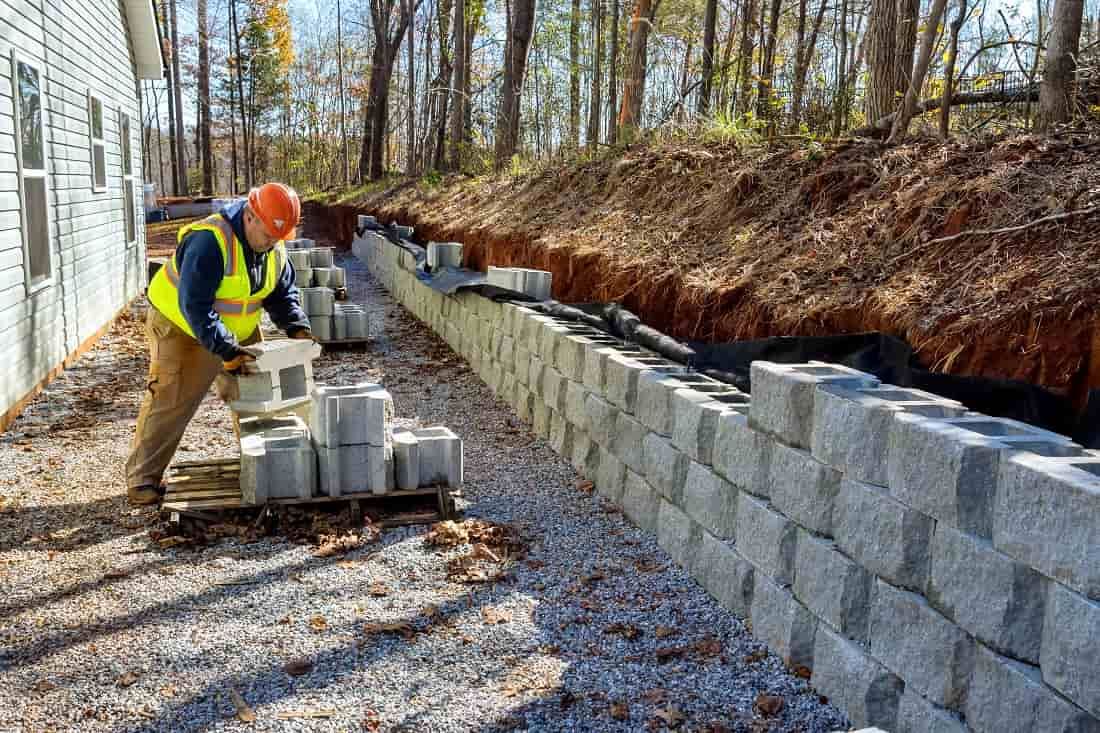
We will get back to you as soon as possible.
Please try again later.
Airdrie Concrete Contractors
587-602-9634
Concrete Retaining Walls In Airdrie Alberta
Building Concrete Retaining Walls In Airdrie
Concrete retaining walls provide a functional and attractive solution for managing slopes, preventing erosion, and defining outdoor spaces. At Airdrie Concrete, we specialize in constructing high-quality concrete retaining walls that are built to withstand the elements and offer long-lasting durability. Our expertly crafted walls are designed to resist cracking, weathering, and shifting, ensuring stability and aesthetic appeal for years to come. We use the highest grade cinderblocks Whether you’re looking to create terraced gardens, enhance your landscape design, or solve drainage issues, trust us to deliver retaining walls that blend strength with style. Contact us today to start your project!
A Comprehensive Guide To Types of Concrete Retaining Walls

Ready to transform your outdoor space with quality cinder block built retaining walls that are built to last? Concrete retaining walls offer the ideal combination of strength, low maintenance, and aesthetic appeal, making them a perfect choice for enhancing your home's landscape. Whether you're managing slopes, preventing erosion, or creating defined garden areas, well-designed concrete retaining walls can significantly improve your property's functionality and visual charm. With a variety of design options available, from sleek, modern finishes to textured patterns, selecting the right concrete retaining wall in Airdrie, Alberta, has never been easier. In this guide, we’ll explore the different types of concrete retaining walls to help you create a landscape that is both practical and beautiful.
Gravity Retaining Walls
Description: These walls rely on their own weight to resist the pressure from behind. They are typically thicker at the base and taper off towards the top.
Applications: Suitable for low to moderate heights and less complex site conditions.
Benefits: Simple construction, cost-effective, and stable due to the wall’s mass.
Cantilever Retaining Walls
Description: Cantilever walls use a reinforced concrete base and a stem that cantilevers from the base to support the soil behind the wall. They are often used for taller walls.
Applications: Ideal for moderate to high retaining walls.
Benefits: Efficient use of materials, can support taller heights, and often more aesthetically pleasing.
Counterfort Retaining Walls
Description: These walls are similar to cantilever walls but include additional concrete "counterforts" or buttresses that help reinforce the wall.
Applications: Suitable for high walls where additional support is needed.
Benefits: Provides greater stability and reduces the thickness of the wall, making it more cost-effective for taller structures.
Segmental Retaining Walls
Description: Consist of interlocking concrete blocks or units that do not require mortar. These walls rely on gravity and friction between the blocks to hold back soil.
Applications: Commonly used for garden walls, landscaping, and terracing.
Benefits: Easy to install, flexible design, and can accommodate various shapes and curves.
Modular Block Retaining Walls
Description: Constructed from pre-cast concrete blocks that are assembled on site. They often include a system of pins or keys to hold the blocks together.
Applications: Suitable for both residential and commercial projects, especially where aesthetics and design flexibility are important.
Benefits: Versatile, easy to install, and available in various colors and textures.
Tieback Walls
Description: Use tensioned steel rods or cables anchored into the ground behind the wall to provide additional support and stability.
Applications: Effective for high walls or in situations where space behind the wall is limited.
Benefits: Provides extra support for high or unstable walls, and minimizes the required wall thickness.
Green or Living Retaining Walls
Description: Incorporate vegetation into the wall design, either through soil-filled panels or integrated planting areas.
Applications: Ideal for environmentally friendly designs and aesthetic enhancement.
Benefits: Provides erosion control, improves visual appeal, and enhances ecological benefits.
A concrete garage floor offers an exceptional combination of durability, easy maintenance, and modern aesthetics for your garage space. With a range of design choices, from sleek polished finishes to durable epoxy coatings, you can achieve a look that is both practical and visually appealing. At Airdrie Concrete, we specialize in creating top-notch garage floors that meet your unique requirements. Ready to transform your garage? Reach out to us today to start your project and create the perfect concrete garage floor for your home.
How to Properly Maintain Your Concrete Retaining Walls?

Concrete retaining walls offer the ideal blend of strength, functionality, and aesthetic appeal for managing soil and creating level landscapes. With various types available, including gravity, cantilever, and modular block walls, you can choose the perfect solution to support and enhance your outdoor space. At Airdrie Concrete, we specialize in designing and installing durable, high-quality cinder block retaining walls that address your specific needs and preferences. Ready to elevate your landscape? Contact us today to begin your project and create a retaining wall that combines both form and function for your property.
- Regular Cleaning: Keep your retaining walls clean by sweeping it regularly to remove debris and dirt. For a deeper clean, use a pressure washer or a mild detergent with a broom or scrub brush. Avoid using harsh chemicals that can damage the concrete.
- Seal the Concrete: Apply a high-quality concrete sealer every 1-3 years to protect the surface from stains, moisture, and UV damage. Sealing also helps to prevent cracks and maintain the retaining walls appearance.
- Address Stains Promptly: Clean up spills and stains as soon as possible to prevent them from setting. For oil or grease stains, use a degreasing cleaner or a mixture of baking soda and water. For rust stains, try a rust remover designed for concrete.
- Repair Cracks and Chips: Inspect your retaining walls regularly for cracks or chips and address them promptly to prevent further damage. Use a concrete crack filler or patching compound for minor repairs. For larger cracks or structural issues, consult a professional.
- Control Weeds and Moss: Remove weeds and moss that grow between cracks or along the edges. Use a weed killer or a mixture of vinegar and water to treat these areas. Regularly inspect and maintain the edges of your walkway to prevent weed growth.
- Prevent Water Damage: Ensure proper drainage around your retaining walls to prevent water pooling or runoff that can lead to erosion or damage. Keep gutters and downspouts clear to direct water away from the walkway.
- Avoid Heavy Loads: Avoid parking or placing heavy objects on your retaining walls that could cause cracking or surface damage. Be cautious with snowplows and heavy machinery to prevent scarring or gouging the surface.
- Protect from De-icing Chemicals: In winter, avoid using harsh de-icing chemicals that can damage concrete. Opt for sand or a salt-free de-icer to minimize potential harm.
- Regular Inspections: Conduct routine inspections of your retaining walls to catch any signs of damage early. Look for signs of cracking, discoloration, or other issues that might require attention.
- Professional Maintenance: For significant repairs or maintenance needs, such as resurfacing or extensive crack repairs, consider consulting a professional to ensure the work is done correctly and effectively.
- Winterization: Winter can be harsh with cold temperatures, ice, and snow. Proper winterizing is crucial to keeping your concrete retaining walls in good condition during the winter months. Be sure to remove any leaves or other debris from your pool deck before the first snow. Avoid using harsh chemicals, such as rock salt, to melt ice, as these can damage the concrete surface. Instead, use a rubber-tipped shovel to remove snow and ice, or a mild de-icing agent designed for use on concrete.
Proper maintenance of your concrete retaining walls is essential for ensuring its longevity and keeping it looking great. By following key practices such as regular cleaning, sealing, timely repairs, and managing water drainage, you can maintain your pool deck’s durability and aesthetic appeal. Routine inspections are also crucial for identifying and addressing minor issues before they escalate. With consistent care, your concrete retaining walls will remain a beautiful and functional part of your outdoor space for years to come.
Why Choose Airdrie Concrete Contractors?
- Locally Rooted Expertise
As locals of Airdrie, we know the region’s climate and soil conditions inside and out. Our tailored concrete solutions are built to last, designed with Alberta’s unique environment in mind.
- Specialized Concrete Solutions
We offer specialized services like decorative concrete, custom stamping, and eco-friendly options that go beyond the basics. Whatever your vision, our expert team brings it to life with precision and creativity.
- Commitment to Quality and Durability
Our commitment to quality means using only premium materials and proven techniques. We build concrete structures that are as tough as they are beautiful, ensuring they stand strong through Alberta’s challenging winters.
- Certified and Experienced Contractors
With certified and highly experienced contractors on board, we bring a wealth of knowledge to every project. Our track record speaks for itself—quality work completed by professionals you can trust.
- Personalized Customer Service
We pride ourselves on offering a personalized experience, from free consultations to customized designs. We work closely with you to ensure your concrete project matches your exact vision.
- On-Time, On-Budget Projects
Deadlines and budgets matter to us as much as they do to you. We’re committed to delivering projects on time and within the agreed budget, with no surprises along the way.
- Innovative Techniques and Equipment
Using the latest techniques and top-tier equipment, we ensure your concrete projects are completed faster, with superior results that stand out from traditional methods.
- Clear Communication and Transparency
We believe in clear, upfront communication from start to finish. Our detailed quotes and ongoing updates mean you always know what to expect—no hidden fees, no guesswork.
- Comprehensive Service Range
From residential driveways to large commercial projects, we handle it all. Our comprehensive range of concrete services makes us your one-stop shop for any construction need.
Airdrie, Alberta, is a vibrant city located just north of Calgary. It is known for its welcoming community, family-friendly atmosphere, and convenient proximity to major highways. Airdrie includes several neighborhoods and smaller areas, such as Bayside, Coopers Crossing, Kings Heights, Reunion, and Williamstown, each offering a unique blend of amenities, parks, and recreational spaces. Whether you're exploring the scenic pathways along the canals in Bayside or enjoying the bustling shops in Sierra Springs, Airdrie has something for everyone. With its growing population and modern infrastructure, Airdrie continues to thrive as a desirable place to live, work, and play.
LET'S WORK TOGETHER!
Airdrie Concrete is your go-to contractor for all your concrete needs. We provide exceptional workmanship, outstanding customer service, flexible and competitive pricing, and a wide range of services. We're committed to completing your project on time and to your satisfaction. Contact us today, and let's discuss how we can help you enhance the beauty and functionality of your property. We look forward to working with you!
QUICK LINKS
COMPANY INFO